Family Music Centers Inc, Burgett Inc Vs Qrs Music Inc, Qrs Musis Technologies Inc, Et Al
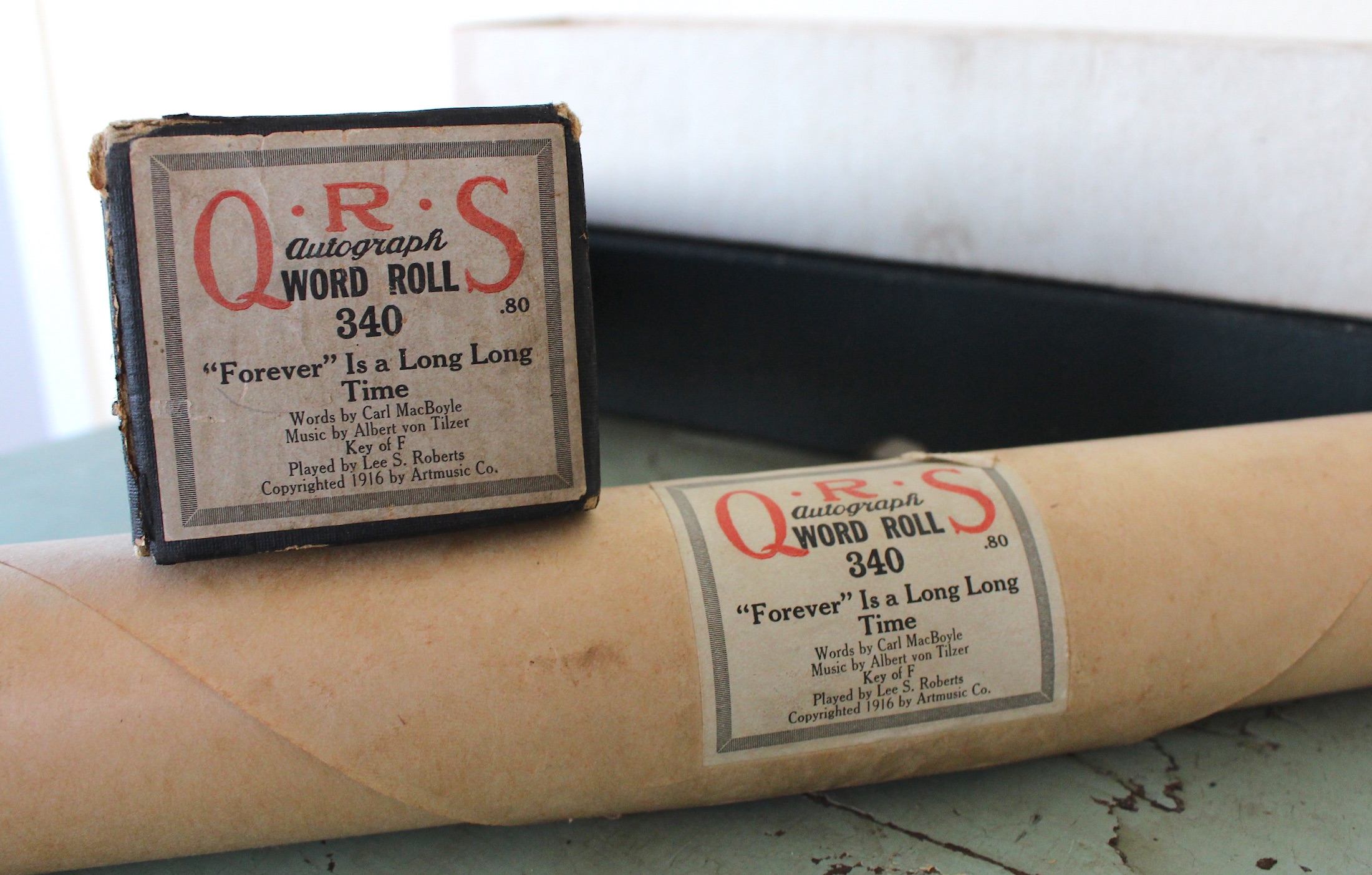
Museum Artifacts: QRS Player Piano "Autograph Give-and-take Scroll" #340 – "Forever is a Long Long Time," 1916
Fabricated By: The Q-R-S Company, 412 Fine Arts Edifice – Manufacturing plant at 4829 S. Kedzie Ave.[Brighton Park]
"Up to the advent of the Q-R-Southward Autograph Curl all thespian piano music rolls were much alike—all made the aforementioned mechanical way. . . The Q.R.S. Shorthand Music Roll is paw played—information technology is practically a photographic record of the mitt playing of an artist. And its playing on your instrument is identical with the manual playing of the artist who made it in the first place. The leading pianists of the state are represented on Q-R-Southward Autograph Music Rolls with all their individuality faithfully recorded." —Q-R-S advertisement, 1913
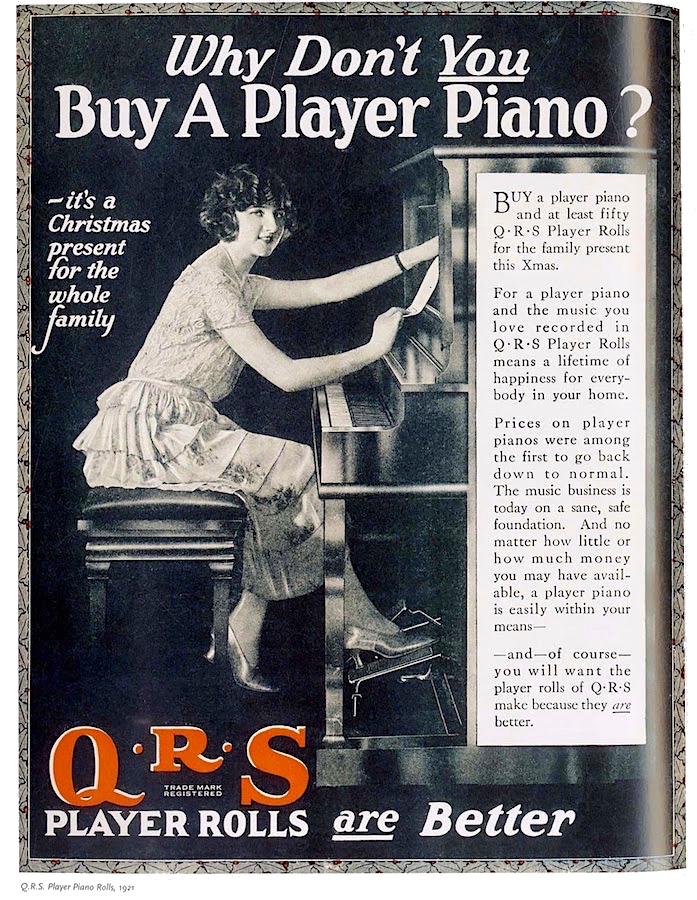
That uncanny combination of magic and mechanization—the proverbial ghost in the motorcar—was all the more gobsmacking to folks in the early 1900s, when radios and record players (let alone televisions) were still a piddling means down the road. Dorsum then, the role player piano became a surprisingly mainstream course of household entertainment—a major investment, to be sure, but popular enough in middle course parlor rooms to support an enormous industry; much of it centered in the established pianoforte-manufacturing hub of Chicago.
The Q-R-S Music Company was born out of this relatively brief but intense phenomenon, becoming the world's largest producer non of player pianos, but thespian piano rolls—the perforated paper sheets that "fed" the instrument its precise musical instructions. To some, QRS and its ilk were purveyors of soulless "machine music," but to others, they were miracle workers of the modern age—bottling and preserving the note-by-notation performances of very existent homo beings, including everyone from George Gershwin and Sergei Rachmaninov to Jelly Ringlet Morton and Fats Waller.
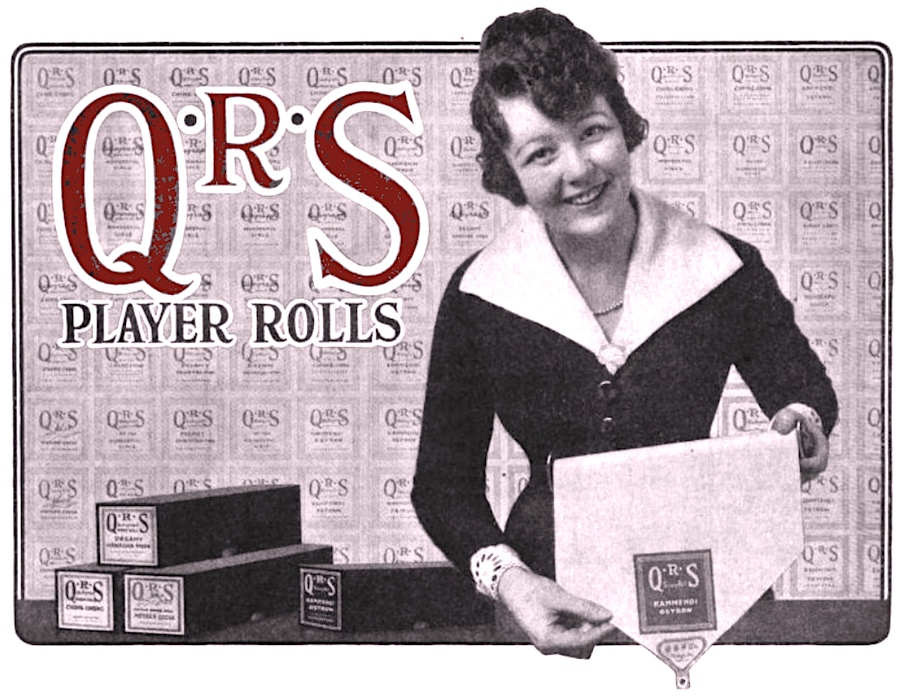
History of the QRS Visitor, Office I. The Artifact
The artifact in our museum collection is a fairly random but representative case of a QRS pianoforte roll from the visitor's early Chicago era. It contains a punch-hole interpretation of the vocal "Forever is a Long, Long Time," a new composition past "Take Me Out to the Abortion" scribe Albert von Tilzer. The tune was copyrighted in 1916 and probable recorded and released a twelvemonth or two later.
Branded as an "Autograph Discussion Roll" (No. 340), our particular unraveled scroll features the piano stylings—and literal signed autograph—of Lee S. Roberts (1884-1949), a prolific songwriter and piano roll recording artist who also happened to exist the vice president of the QRS Co.
"I had no intention of becoming a pianist or composer," Roberts said in 1921. "I owe all my achievement and success in that direction to the influence of the player [piano] and the extensive amount of musical literature with which information technology surrounded me."
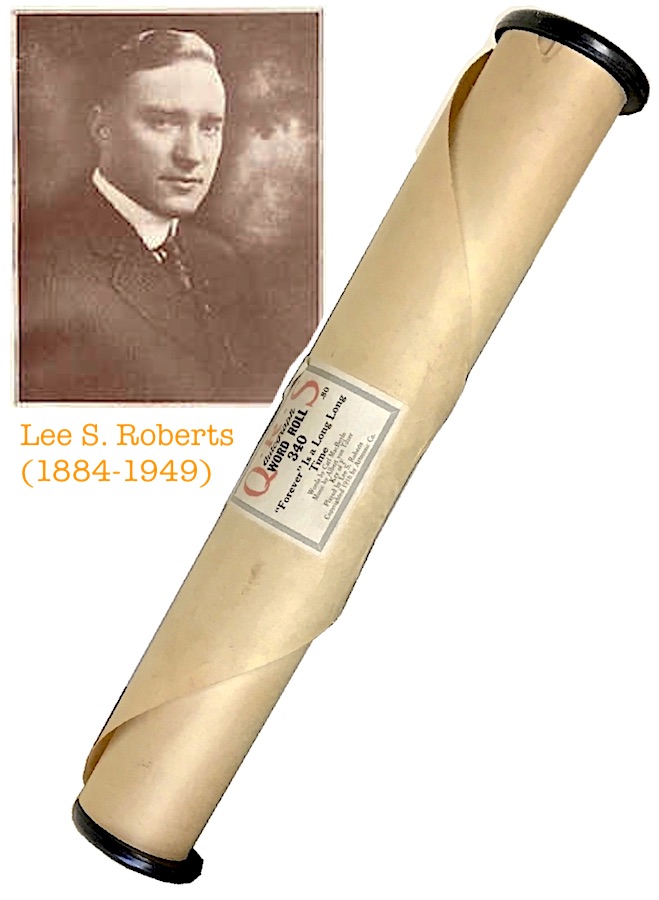
In essence, and so, the piano whorl captured Roberts' personal rendition of "Forever is a Long Long Time" similar a photograph—or possibly more than like a slightly doctored photo, as edits and alterations were as well part of the manufacturing procedure.
One time that master curl establish its mode to the QRS manufacturing plant, a perforating automobile could follow its pattern to produce hundreds of identical copies, which would then be distributed to retailers across the land, including the reputable Chicago music dealer Lyon & Healy, who boxed and sold our specific museum artifact.
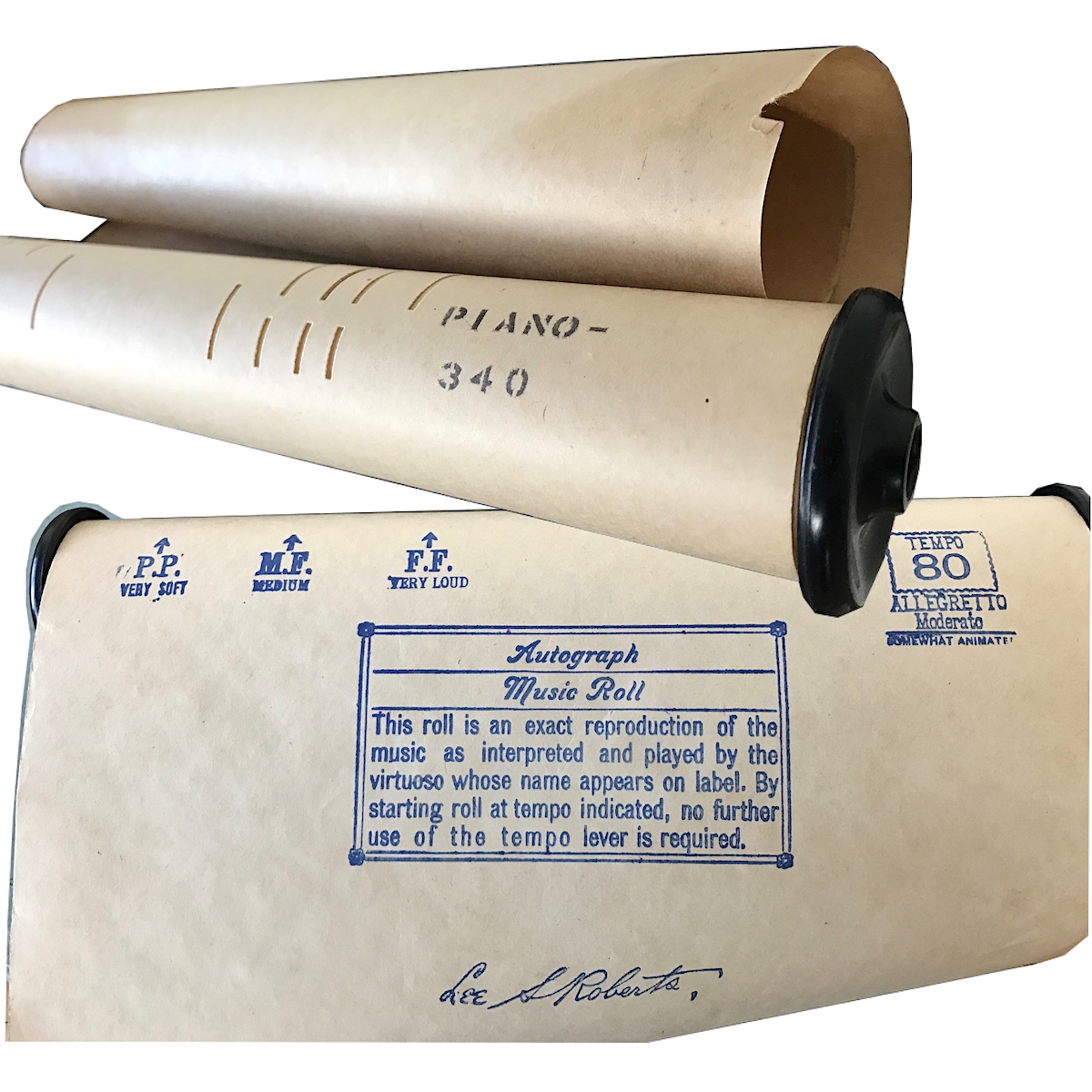
From there, at the average cost of 25 or 50 cents ($half dozen to $12 in today's coin), a customer would have picked upward this hot new jam of 1916 and eagerly brought it home to play for the family.
Virtually player pianos had a built-in compartment centered above or below the keyboard, where the roll (wrapped around a spool) could be inserted into the actor machinery, or "stack."
"As the newspaper is fed through the role player piano," according to noted piano whorl transcriber Artis Woodhouse, "it is read by the role player machinery, which trips the pianoforte hammers to strike the strings. The position of holes along the width of the curl determines the pitch of the note, the position of holes along the length of the gyre determines when in time the annotation occurs, and the length of the holes determines how long the notes are held." This amazing mechanism functioned on pneumatic principles, with pushed air moving through the holes in the paper and back through various valves and bellows to communicate its intended sound.
Some of the early on pianolas and player pianos were rightly criticized for a clunky, stilted playing style that fell far brusk of recreating the subtle art of the human mitt. New improvements in the technology began rapidly upgrading the simulation in the early 1900s, however; many of them credited to the piece of work of a man named Melville Clark, a Chicago based inventor and manufacturer who—conveniently enough—is also generally recognized as the founder of QRS.
Part 2: Clark'due south Story
A native of Oneida County, New York, Melville Clark (b. 1848) came from a family of artisans and craftsmen. His father Thomas Clark was a film frame maker, his older brother George Waldo Clark ran a music store in Syracuse, and his younger brother Ernest G. Clark would eventually pb the QRS music roll team and the Clark Orchestra Roll Company. Melville fifty-fifty had a famous nephew of the aforementioned name—George'due south son Melville A. Clark (b. 1881)—who ran his own carve up instrument business organization in Syracuse (the Clark Music Co.) and found neat success equally the inventor of the Clark Irish gaelic Harp; the kickoff portable string harp.
The "original" Melville Clark, meanwhile, ever kept his focus on keyboard instruments. Starting out as a piano tuner and organ architect in Syracuse, he made a bold move to the westward declension in 1875 to organize his first business (Clark & Co., Oakland, CA); so relocated to Chicago, where he ultimately joined upward with Hampton L. Story to class the famed Story & Clark Company in 1884. S&C was initially an organ manufacturer, but the company began producing pianos in the 1890s, and their reputation was stellar from the outset; particularly in regards to the innovative chops of Melville Clark.
"At that place is probably not a single manufacturer in the country who has a superior personal knowledge of mechanism and principles of musical musical instrument industry than Mr. Clark," one trade periodical proclaimed in 1891, "and certainly no homo whose brain is more than fertile in the originating of improvements."
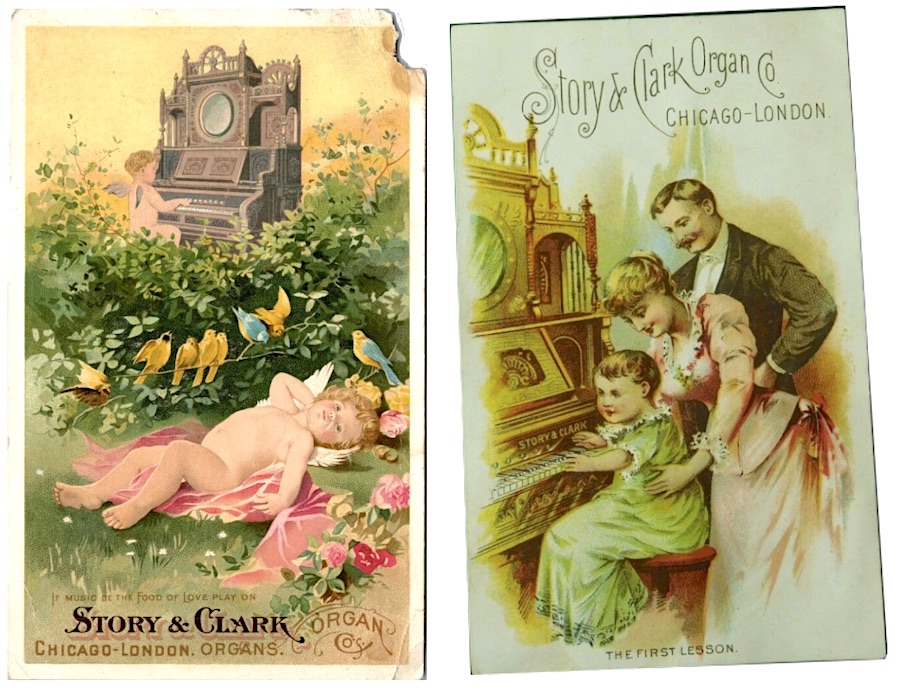
[Victorian collector cards advertizement the Story & Clark Company, circa 1890]
After traveling to Europe in the early 1890s and observing new developments in mechanized self-playing "pianolas," Melville returned to Chicago with a new obsession—one well suited to the inventive spirit of the Columbian Exposition.
Everybody liked listening to a good pianoforte tune, he figured, simply a relative few had the skill and patience to play the instrument at a high level. The player piano met the public halfway; serving both as a highly avant-garde "music box" and an educational tool for prospective pianists and visual learners.
Finally, in 1900, Melville elected to "become solo," as it were, respectfully parting ways with Story and forming an entirely new enterprise built around his latest inventions: the Melville Clark Pianoforte Visitor. As ane of the preeminent pianoforte men in the country, this made for big news non simply in the highly competitive Chicago market, simply beyond the industry.
"One of the near important happenings of the week in this city has been the organization of the Melville Clark Piano Co. and the divorce, after sixteen years of shut association, of the interests controlled past Melville Clark and the Storys," the Music Trade Review reported on Feb 17, 1900. ". . . Information technology is the intention of the Melville Clark Piano Co. to make the Clark piano an instrument of high grade, and which by reason of Mr. Clark'due south scientific ability and prestige, as well as the quality of its manufacture, volition command a special position in the field."
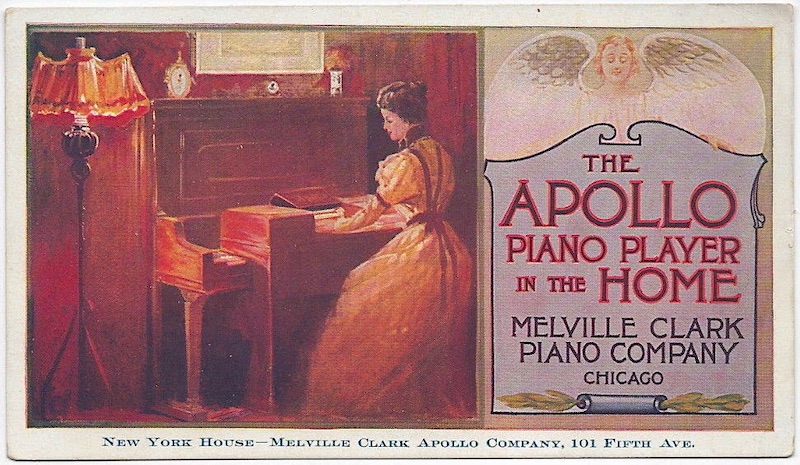
From its first plant on West Madison Street, the Melville Clark Company soon had 150 men and women in its employ. Many were working to produce the world'due south beginning mechanized, 88-notation upright pianoforte with a built-in player mechanism; a Clark invention that he dubbed the "Apollo" (previous options on the market were normally limited to 65 notes). Rather than using a vacuum motor to run the music rolls—equally was mutual in other models—the Apollo used a spring-wound clockwork motor that was wound past pumping the pianoforte'southward pedals. Later models required no man guidance at all, a factor which differentiates a "reproducing piano" from a standard actor piano.
From early, a department was also established within the Melville Clark plant for recording and manufacturing a new line of paper piano rolls that would work exclusively with the Apollo. Likely for legal reasons, Melville elected to make this coil department a separate company unto itself, and installed his highly capable younger brother Ernest Grand. Clark as the first president of the new subsidiary, which would be known—somewhat inexplicably—as the Q-R-S Company.
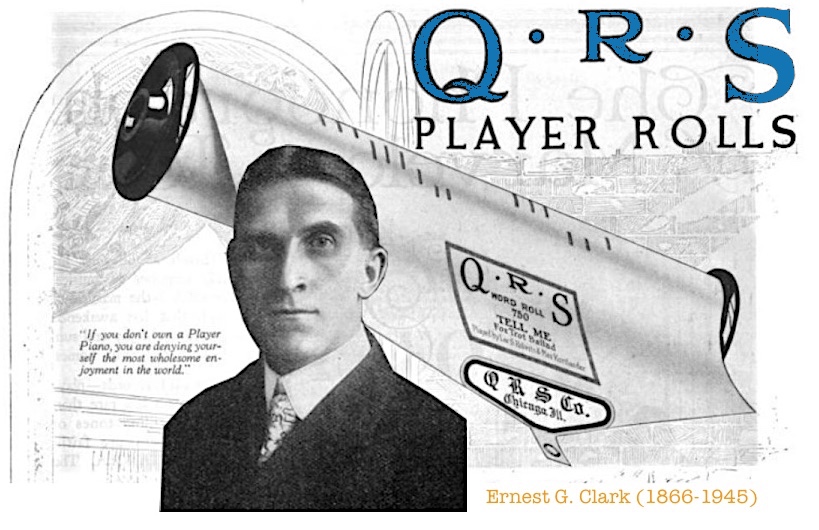
Iii. It Ain't an Acronym
While advertisements would later suggest that the three letters stood for "Quality Existent Service," the actual origin of the proper noun Q-R-Due south remains something of a mystery. One theory is that the mail section at the Melville Clark Visitor was overrun with roll orders, filed under "R," and that workers had to utilize the adjacent "Q" and "S" dove holes on either side. Another article in a company bulletin in 1918 (suggesting the origin of the proper noun had already been lost by that point) guessed that maybe the letters had been a reference to "arousing people's Q-R-oSity." Ugh, promise non.
Whatever the inspiration, the QRS Company remained trivial more than a wing of the Melville Clark Co. through the first decade of the 1900s, although Ernest Clark was proving just equally mechanically savvy every bit his older brother, eventually collecting more a dozen patents related to the construction and use of perforated music rolls.
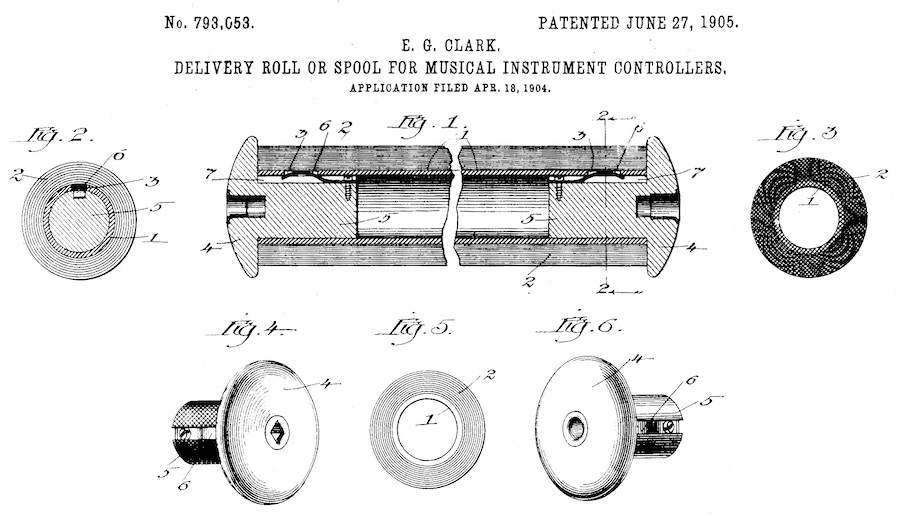
[An early Ernest G. Clark patent for a "delivery whorl or spool for musical instrument controllers," 1905. While Ernest was eighteen years younger than his brother Melville and routinely overshadowed, his inventions were only every bit important to the success of both the Apollo pianos and QRS rolls]
Most of Ernest'due south new creations were put into use in a major new factory that the Clark Visitor and QRS established in DeKalb, Illinois; a railroad-friendly town near 60 miles west of Chicago.
At the grand opening of the DeKalb institute in 1905, Melville Clark told reporters he expected to exist able to produce two,500 traditional pianos and every bit many as iv,000 player pianos per year. These were mighty ambitious goals for an upstart company competing against numerous rivals in a brand new field, just some fundamental developments over the side by side few years validated Clark's confidence.
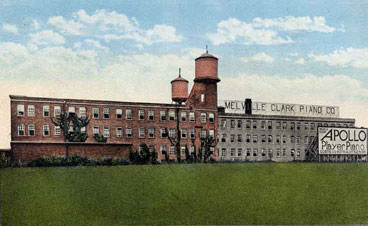
Commencement, in 1907, Clark was victorious in a high-profile court example that rocked the industry. Ruling in White-Smith Music Publishing Co. vs. Apollo Visitor, the U.S. Supreme Court determined that music roll makers didn't take to pay royalties to composers, as the rolls were deemed to be part of a machine, rather than clearly identifiable copies of copyrighted sheet music. This case became surprisingly relevant many decades afterward, when similar lawsuits emerged effectually computer program coding.
The adjacent big win for Clark and QRS came a year later, in 1908, when a piano manufacturers convention in Buffalo, New York, concluded with the 88-note piano roll being officially adopted as the manufacture standard format, validating Melville's blueprint and sending many of the early 65-annotation pianola purveyors to their doom.
In the long run, standardization was a victory for the whole manufacture, as the public no longer had to fret about which various roll formats would work in which pianos. This convenience, and the emergence of a booming ragtime dance craze, led to exponential sales growth. In 1909, an estimated 45,000 player pianos were sold in the country, and by 1919, that tally had more than quadrupled to 208,000 units sold—loosely mirroring the growth in machine sales during the same decade. To put it in another context, an estimated 85% of all pianos sold in the U.South. between 1910 and 1925 were "automatic," with at least some mechanical accompaniment built in.
For an instrument we now recollect of equally a pure novelty, it tin be hard to wrap our 21st century heads around those numbers, especially when you lot consider that even a depression-cease thespian-pianoforte in the 1910s was selling for $300-$500; about the same as a Model T Ford, and equivalent to roughly $five,000 to $8,000 in today's money. The surprising popularity of these big expensive machines only really makes sense against the stark absence of feasible music-listening alternatives.
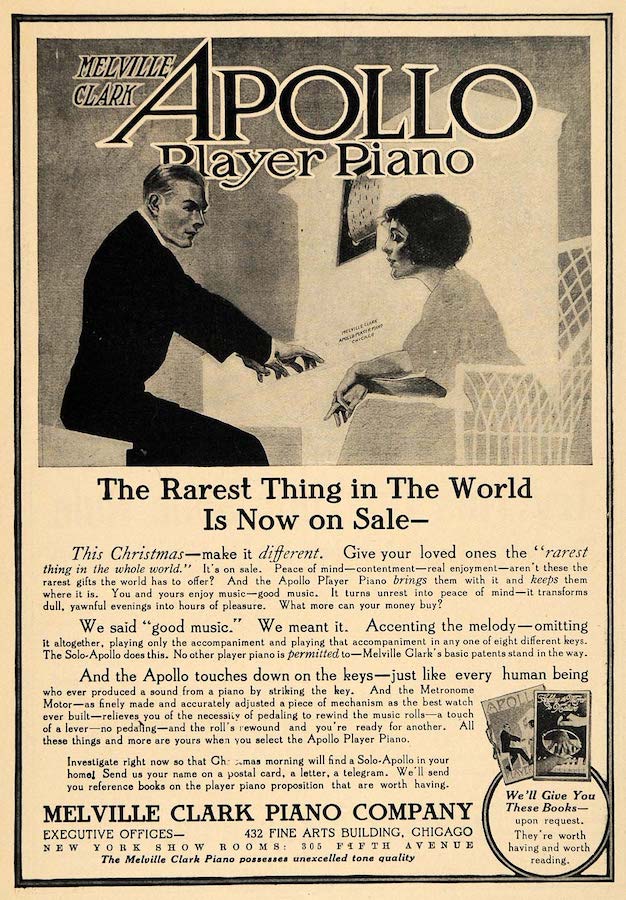
A player piano offered a new hope . . . not a crude recording cranked out through a horn, but a genuine performance physically communicated through the hammers and keys of the piano itself—shut to how information technology might sound with a capable person tickling the ivories. Young musicians could also use the piano rolls as accompaniment while they honed their own skills, and struggling composers could find a new audience with greater ease than just selling their unheard sheet music on street corners.
Better still, just about any popular vocal under the sun could be added to your own personal concert drove simply by picking up the latest QRS piano curl at your local music shop. There was rarely a shortage, as the QRS plant in DeKalb was boxing up about 4,000 rolls per day by 1912.
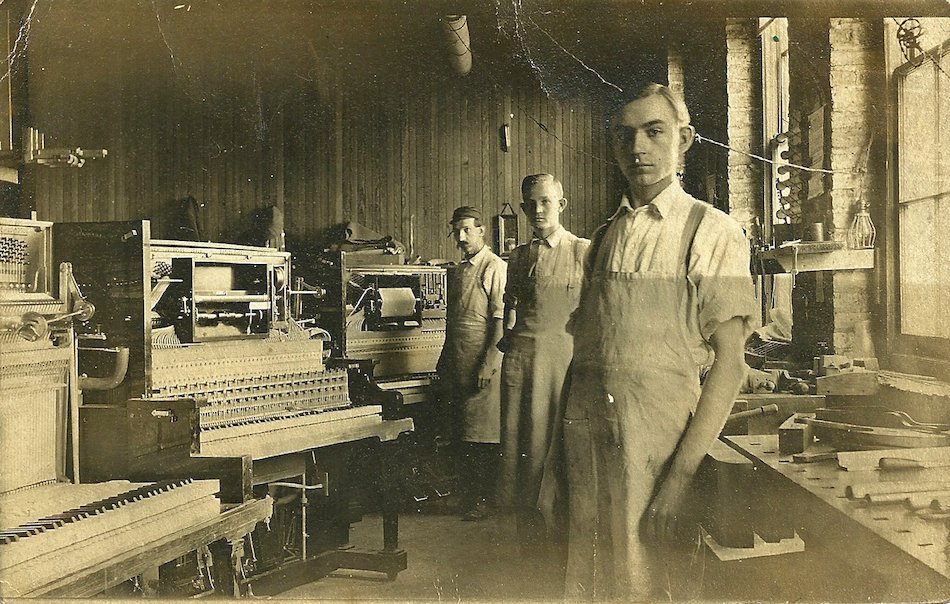
[Factory workers at the Melville Clark / QRS establish in DeKalb, IL, c. 1915, courtesy of DeKalb Daily Chronicle]
Iv. Soul of the Performer
"Q-R-Due south Thespian Rolls are made from the 'master patterns' which are recorded from the hand playing of great pianists. Expense is not spared in making Q-R-S 'masters.' No pianist is besides prominent—no fee also big to pay for the sake of getting out a Q-R-Southward Roll that is upwardly to our quality standard." —QRS Company ad, 1919
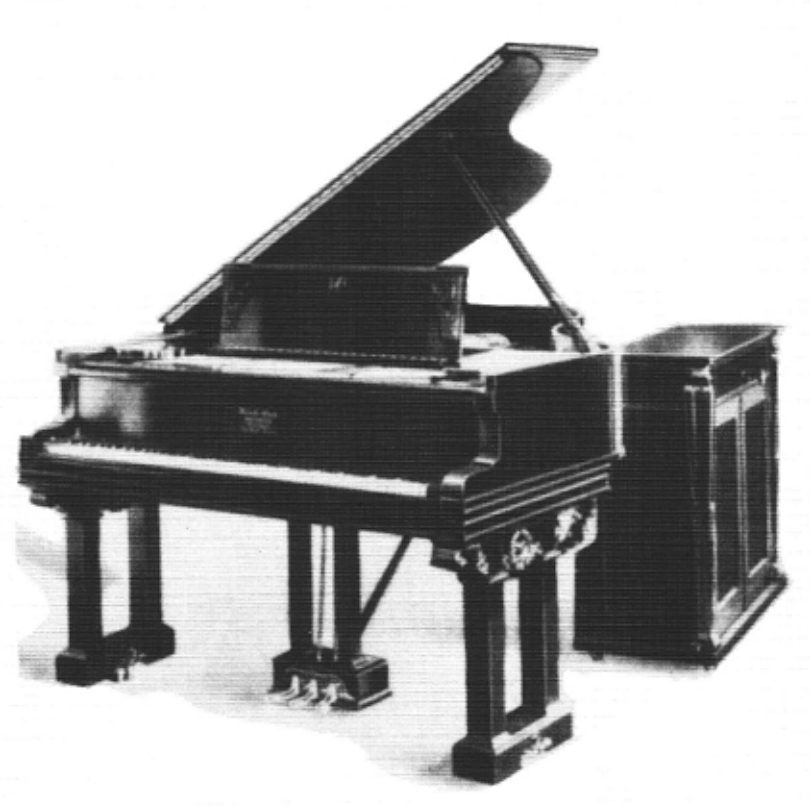
In 1912, Melville Clark made arguably his biggest contribution to the music industry, inventing the QRS Mark Pianoforte (aka the Apollo Marking Piano)—the vehicle through which a live pianist could straight mark each note he hit onto a carbon cylinder every bit he played. Earlier this, QRS master rolls were generally hand-punched by draftsmen using rulers to simulate the spacing of a keyboard, leading to a lot of the problems with stilted playback. This new innovation* was a major game changer for "natural" audio recording, and was after described by music historian Alfred Dodge as doing "more than than the phonograph and photographic camera combined, because it reproduces the soul of the performer."
*In 1992, 80 years after its invention, the QRS Marking Piano was named an official "National Historic Mechanical Engineering Landmark" by the American Society of Mechanical Engineers.
Later on the development of the marking piano, some of the best known and respected pianists in the globe—including many who'd in one case been skeptical of automated instruments— were increasingly willing to bring together the music roll revolution and cut their own cylinders. Even the great Sergei Rachmaninoff, upon listening back to his ain first piano roll recording in 1919 (for the American Pianoforte Company, a QRS rival), supposedly said, "Gentlemen, I, Sergei Rachmaninoff, have but heard myself play!"
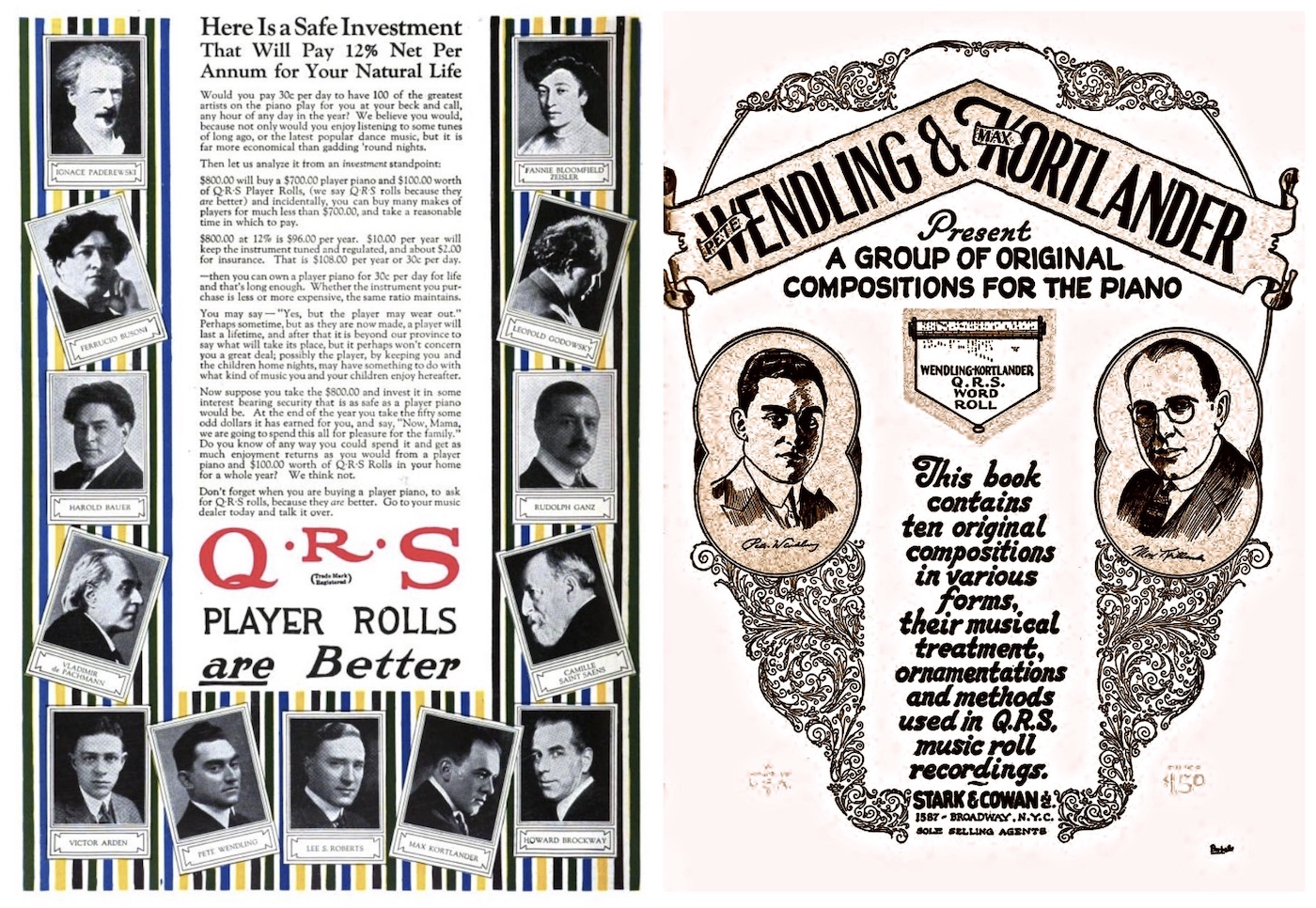
[Left: 1922 advert featuring some of the musicians featured on QRS piano rolls, ranging from classical composers similar Camille Saint-Saëns to QRS employees Lee S. Roberts and Max Kortlander. Right: 1924 canvass music compilation volume featuring some QRS piano rolls compositions by Kortlander and Pete Wendling]
QRS didn't necessarily demand to get out recruiting famous concert performers—by the late 1910s, the visitor had built its own team of regular in-house contributors, including the same company VP Lee S. Roberts, as well as highly accomplished player/composers Peter Wendling, Zez Confrey, and the "King of the Thespian Piano," Max Kortlander. While all of these men were white, QRS had been more than progressive than most of its competitors in recording blackness artists, likewise, including a serial of rolls past John "Blind" Boone that were released back in 1912—among the earliest recordings ever made of a blackness musician.
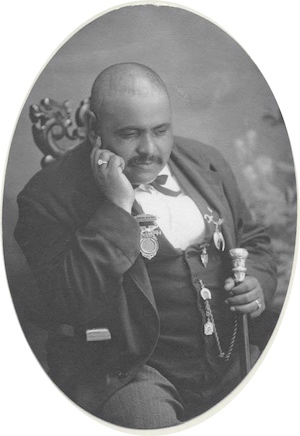
For years, the songs of American popular music had e'er mattered more than the artist, but this was quickly changing equally music buyers began to develop affinities for the styles of sure players. And since the same songs and performers would oftentimes be constitute on piano rolls produced by different companies, the reputation of each manufacturer and the quality of their sound became increasingly important, as well.
"If you already have information technology in a roll of another make," read i 1916 ad for the new recording of Whose Pretty Babe Are You Now?, "hear this QRS Discussion Roll. Then y'all'll empathise why xc% of the dealers in Chicago sell QRS rolls."
Standing out from the crowd wasn't ever like shooting fish in a barrel. During most of the 1910s, QRS was all the same battling dozens of well known competitors, including names like Ampico (New York), Standard (New Jersey), and a few primal rivals that would later get QRS acquisitions: Connorized (New York), Vocalstyle (Cincinnati), Regal (Chicago), and the United states of america Music Co. (Chicago). From their ain corporate offices in Chicago'southward Fine Arts Building, the QRS creative squad was always at work rolling out (pardon the pun) new features and gimmicks to keep pace, highlighted past the popular "Word Whorl"—which printed the song's lyrics directly on the canvas—and the related "Story Curl" and "Female parent Goose Scroll" for sing-a-longs with the kids.
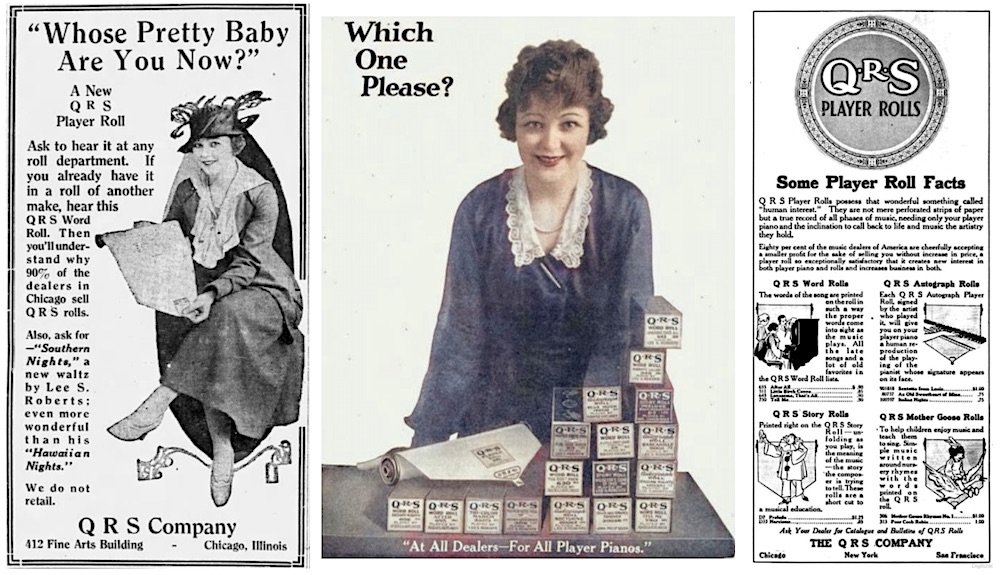
It was shortly articulate, though, that keeping up with the changing musical preferences of the public would really determine which companies sank or swam. By 1916, the Aeolian Company of New York—the country'south largest role player piano manufacturer—had already employed the African American pianist James P. Johnson as its new ringlet recording star. And over the adjacent couple years, the Groovy Migration of black musicians from the South connected to bring a new, energetic new fashion of ragtime to American cities—setting the template for the jazz historic period, and creating a fork in the road for the sensibilities of the QRS Company.
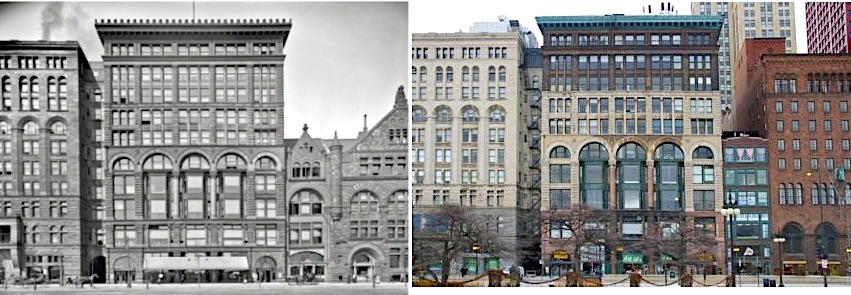
[In a higher place: The QRS and Melville Clark corporate offices were located in Chicago's Fine Arts Building at 412 Southward. Michigan Ave. for much of the 1910s, seen in a higher place then and now. Beneath: 400 employees of Clark and QRS attend a service flag raising at the DeKalb campus in 1918]
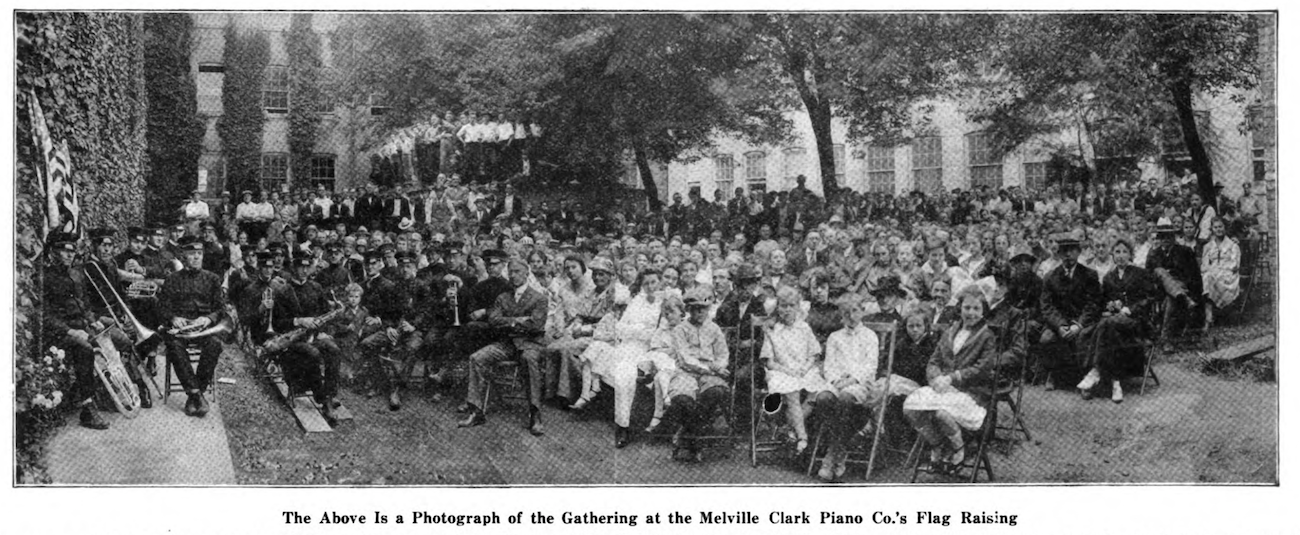
V. New Blood
The modify in the music scene, information technology turns out, coincided perfectly with a major shake-up in the QRS offices. In Oct of 1918, it was appear that the decision-making interest in both QRS and the Melville Clark Company had been purchased by Thomas Grand. Pletcher (b. 1871)—a general director with the business who'd started out every bit a salesman fashion back in 1903.
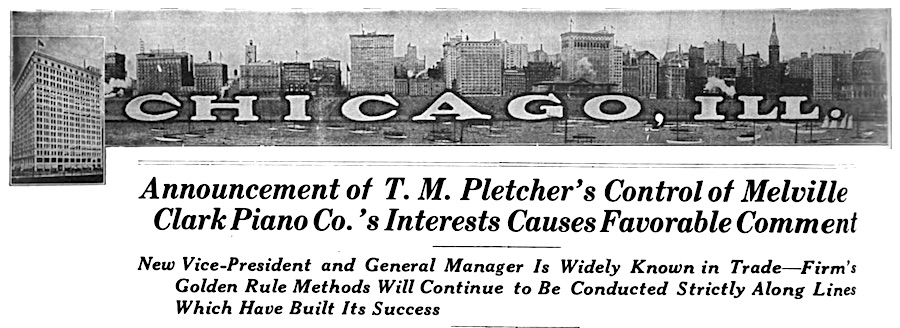
Co-ordinate to an article that month in the Music Trades, "The decision of Melville Clark to relinquish the control of the two companies is the result of long deliberation. For some fourth dimension Mr. Clark, who has been a ascendant factor in the music industry for many years, has felt that he was entitled to take things easier—to place himself in a position where he could fully savour the fruits of his many years of successful climbing in the merchandise. He expressed this wish to his assembly and the large deal resulted. One condition, nonetheless, on which he agreed to relinquish the active control of the business organisation was a personal assurance from Mr. Pletcher that the business would continue to be conducted strictly forth the lines which take built its success—the Gold Rule methods—and that the same standard of excellence in the diverse products would be rigidly insisted upon."
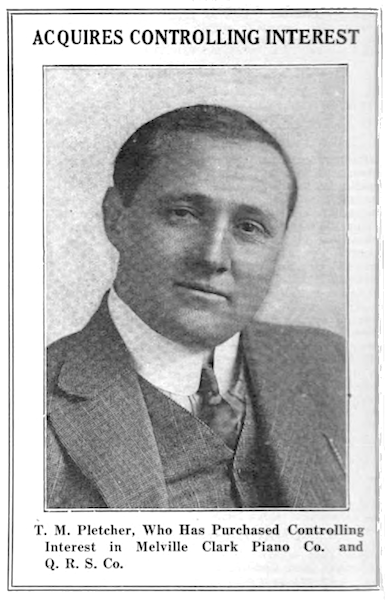
For his office, Tom Pletcher said he looked forward to giving "more time to the development of the business both in this and foreign countries," simply added that Melville Clark was "still essentially interested and will give the company the do good of his genius, judgment and wide experience."
Well, that didn't quite go to plan. Melville Clark, age 70, would be dead within a few weeks of the sale, marker the official end of an era. At a subsequent coming together of the Chicago Piano Manufacturers Association, Clark was widely praised by all his old friends and rivals—including reps from Lyon & Healy, the Cable Pianoforte Co., the George P. Aptitude Co., and the Due west.W. Kimball Co., forth with QRS cohort Lee S. Roberts, who stayed on every bit vice president under Pletcher.
Less than a year later on, in the summer of 1919, Pletcher sold the Melville Clark Company and its distribution fly, the Apollo Piano Co., to the Wurlitzer Visitor, which took over the entire DeKalb establish. The QRS Company, however, wasn't part of the deal. Instead, Pletcher relocated the now fully independent piano curl business back to Chicago, renting space in an existing constitute at 4829 S. Kedzie Artery.
Pletcher also moved forward with new factories in San Francisco and New York City, including a major, modern new facility that opened in the Bronx in 1920. Max Kortlander—the aforementioned "king of the role player piano"—was dispatched to run the NYC recording department, and from coast to coast, QRS'southward new young leadership wasted footling time actively recruiting more various musicians who could better represent the tastes of the Roaring '20s.
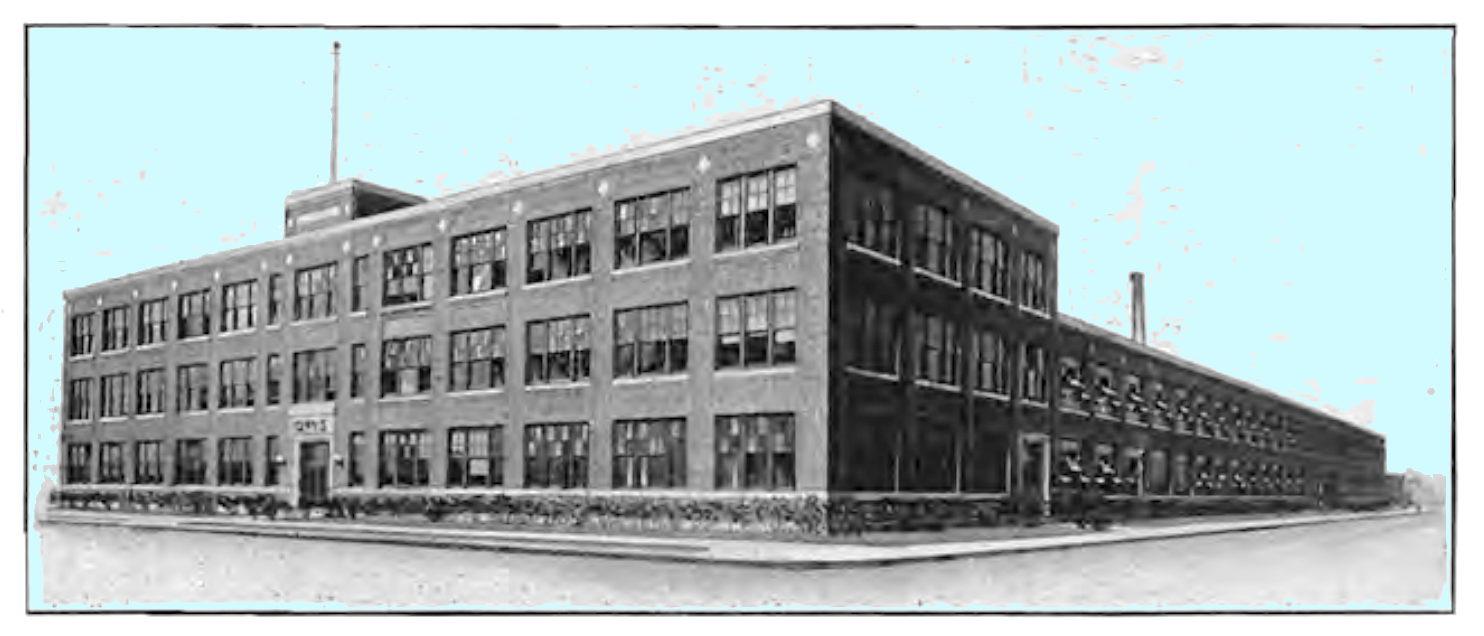
[The QRS Chicago factory at 4829 Southward Kedzie Avenue, in apply from 1919 to approx.1932. Information technology was later endemic by International Harvester and ultimately torn down most the end of the century]
This would eventually lead to recording sessions with some of the early icons of African American jazz and blues, including James P. Johnson himself (composer of the decade'due south biggest trip the light fantastic toe craze, "The Charleston"), noted Chicago piano men Clarence "Jelly" Johnson and Clarence M. Jones, and future legends Fats Waller and Jelly Whorl Morton; the latter of whom is believed to have cut his QRS rolls at the Chicago manufacturing plant.
The most pregnant QRS recruit of the early '20s, though, was a bottom known musician named J. Lawrence Melt—the man would become the unmarried well-nigh prolific pianoforte coil recording artist of all time.
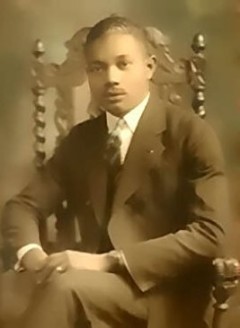
Built-in in Tennessee in 1899, Cook was a wunderkind African American pianist and arranger who is estimated to have produced and/or recorded as many as 20,000 different rolls across a 50+ year career—the vast bulk of them for QRS.
Co-ordinate to census and typhoon records, Cook briefly lived on Chicago'southward S Side in the tardily 1910s, doing several odd jobs, including a gig with the Novelty Candy Visitor. It'due south possible his musical skills beginning came to the attention of QRS during this flow, but he didn't officially join the company on a permanent ground until 1923, when he came to piece of work under Max Kortlander in the Bronx role.
Forth with the endless rolls credited directly to Cook at the keys, there were many hundreds more in which he did well-nigh of the heavy lifting for other artists, arranging and editing even the likes of James Johnson and Jelly Roll Morton. The instance has been made that no man did more to bring blackness music into mainstream America than J. Lawrence Cook, but his skills went far beyond any single genre, equally he was but as adept interpreting a classical slice or—years subsequently—a Beatles tune.
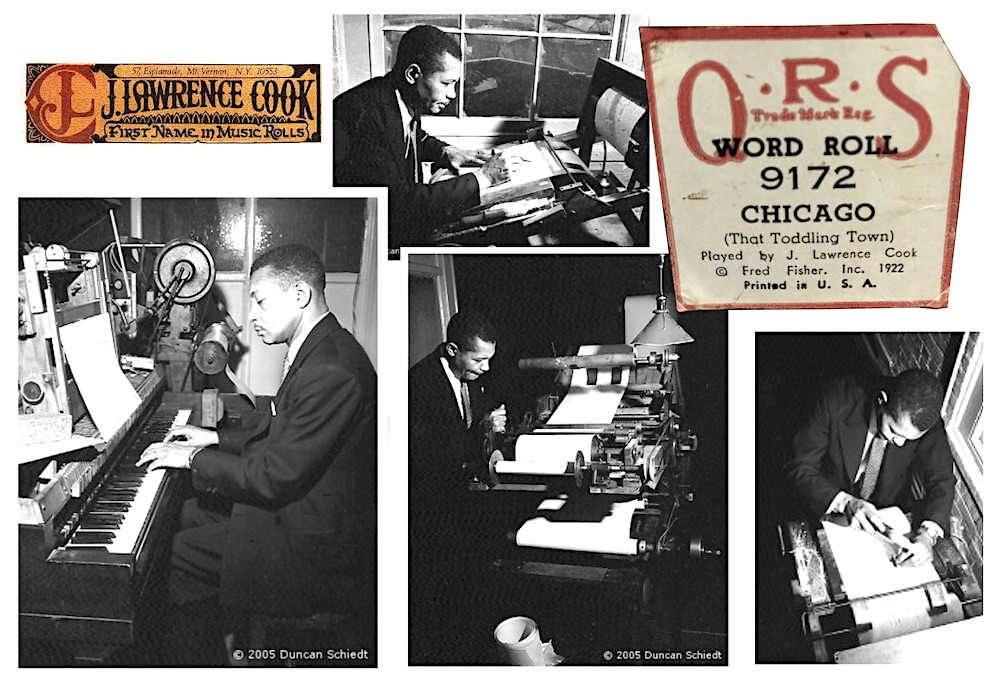
[Above: J. Lawrence Cook at work at the QRS offices in New York. Below: Cook'southward arrangement of "Tea for Two," from QRS piano ringlet #2894]
Half-dozen. On a Curl
"The factories of the Q-R-S Music Co. in Chicago and New York are working night and twenty-four hours at present and expect to keep up this step for some time to come," the Music Trades reported in 1921. Thomas Pletcher was quoted in the story adding that, "Whatever other factories are doing, ours are running on time and overtime." This was a veiled reference, maybe, to the fact that new options in home music entertainment—specifically the radio—weren't causing whatsoever concern in the QRS firm.
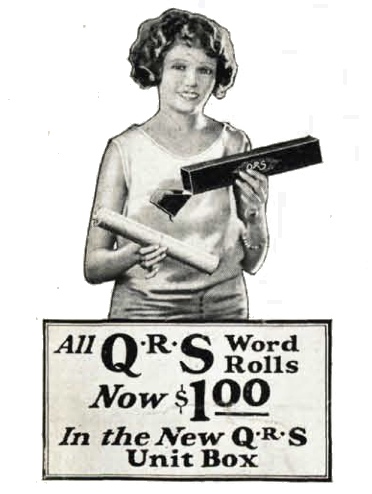
While the Bronx establish was now the master hub of the firm, the Chicago factory was still thriving, and its employees—a mix of men and women—seemed to accept a pretty good working environment, if you believe the Music Trades.
"The Q-R-S Music Co., equally well equally providing the best possible conditions for its employees during working hours, too puts forth every attempt to make their social life enjoyable," read an article in 1923, recounting a recent Valentines Dance held at the Chicago factory.
"These efforts, in face of the labor troubles and dissatisfaction frequently met these days, have resulted in making the entire strength 'hit on all twelve' and are crusade for pride on the part of the company. . . . This dance and this happy group of persons who make the music rolls that make thousands of others happy all over the country are due to the efforts of T. A. Cunningham, full general factory manager of all the QRS factories, and Tom Spence, superintendent of the Chicago factory, who arranged the affair."
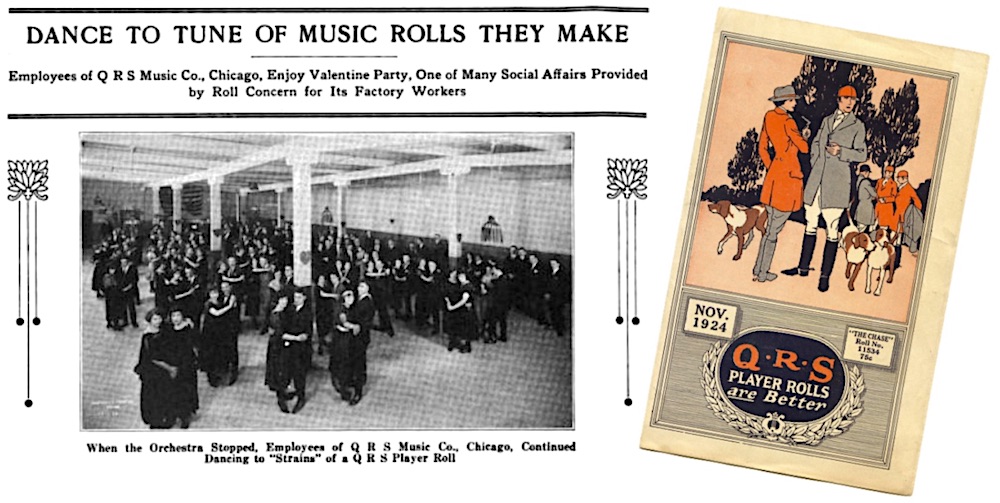
Tom Pletcher, to his credit, wasn't expecting to keep dancing his manner to countless success. An expert salesman, he saw radio and record players every bit the legit threats they were, and he tried his all-time to put QRS in position to diversify and compete.
In the early on '20s, the visitor started making its own piano roll cabinets, speakers, and portable phonographs, but had trivial luck carving out a new niche. Pletcher likewise established a potentially lucrative partnership with the Chicago visitor that would soon be known as the Zenith Radio Corp, taking over the industry of their CRL receivers and developing a line of "Red Height" radio tubes. Zenith'due south president, Eugene F. McDonald, fifty-fifty fabricated Pletcher a vice president at the radio firm for a few years, only when the QRS factory proved unable to continue up with Zenith's growing demands, the working human relationship sputtered out.
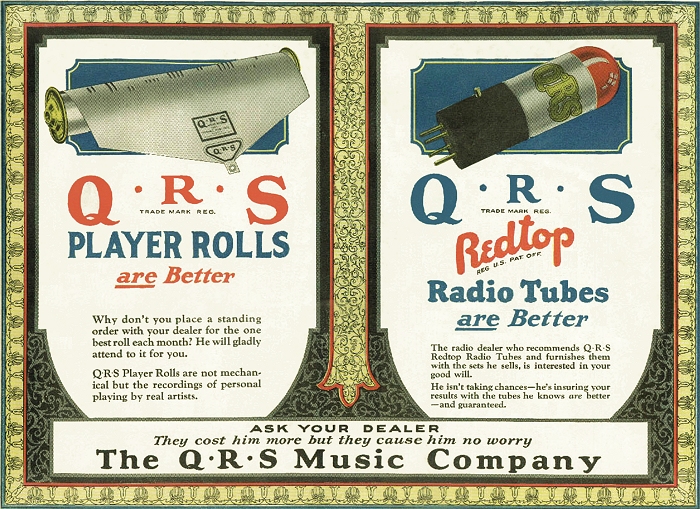
Pletcher's last big Hail Mary toss for product diversification came in the spring of 1929, when QRS purchased Chicago's DeVry Corporation, a major producer of movie cameras and projectors. The new combined entity, QRS-DeVry, sought to get Chicago'due south ultimate dynamic force in visual and audio entertainment, and even expanded into some intriguing / bizarre new types of automatic instruments, such as the QRS "Playasax." Unfortunately, the timing of this bold new venture was downright atrocious.
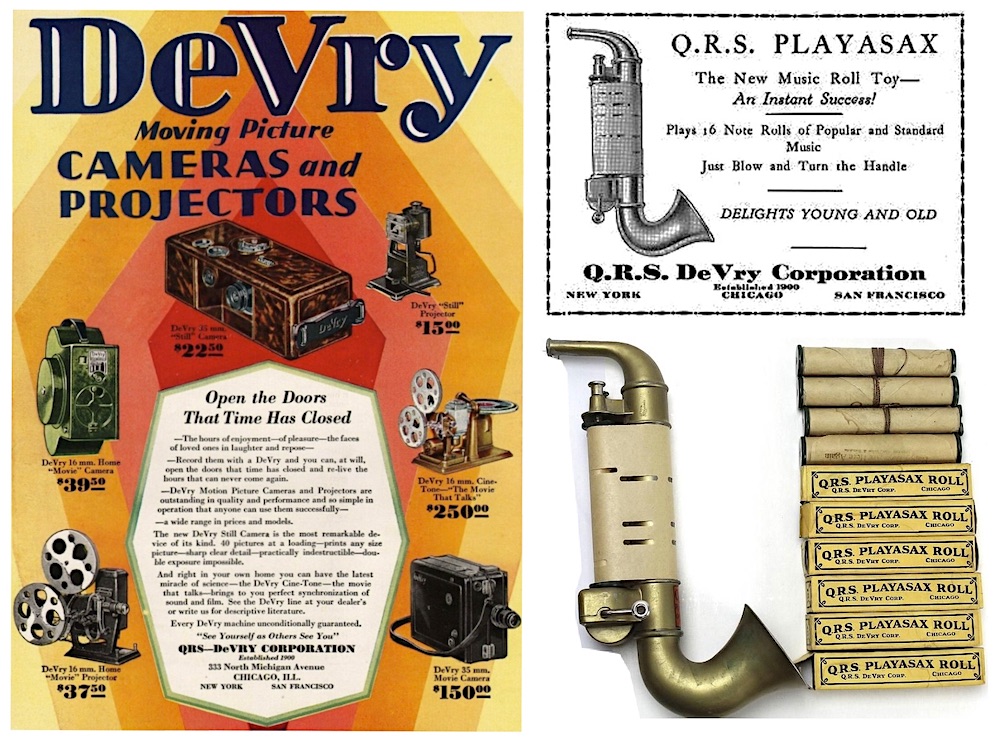
[Left: Advertisement for QRS-DeVry photographic camera and projectors, 1929. Right: Ad for the automatic "QRS Playasax," 1929, along with an image of the instrument and its associated music rolls]
VII. The 2d Life of Q-R-S
The easy narrative is that the stock marketplace crash in October of 1929 pulled the carpet out from nether QRS-DeVry. Afterward all, just 2 years earlier, QRS had its highest piano roll sales numbers in its history, and just about all its erstwhile competition had been bought out. In reality, Thomas Pletcher was walking a tightrope for most of the late 1920s, acquiring other roll manufacturers largely because they were there for the taking—the manufacture was getting crushed by radio and phonographs. The marketplace crash merely provided the final blow.
Past 1932, Pletcher was forced to start disbanding QRS-DeVry piece by piece, including selling the AV office of the business back to Herman DeVry and shutting downward the Kedzie Avenue constitute (which eventually came under ownership of International Harvester). This was, officially speaking, the end of the QRS Company in its original incarnation, and the end of its days as a Chicago business. It was not, however, the end of QRS pianoforte rolls.
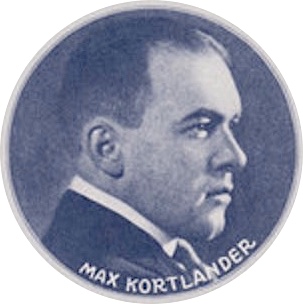
Through the 1940s and '50s, Melt remained the well-nigh important talent at Imperial, which revived the QRS brand proper noun during a nostalgic wartime revival in piano curlicue sales. Despite being one of the most heard recording artists of the early 20th century, though, Cook never achieved fame beyond the niche world of music roll aficionados, nor did he make a fortune from his work. Through most of his career, he kept a second job with the New York City Mail Role, retiring more on the government pension than his musical earnings.
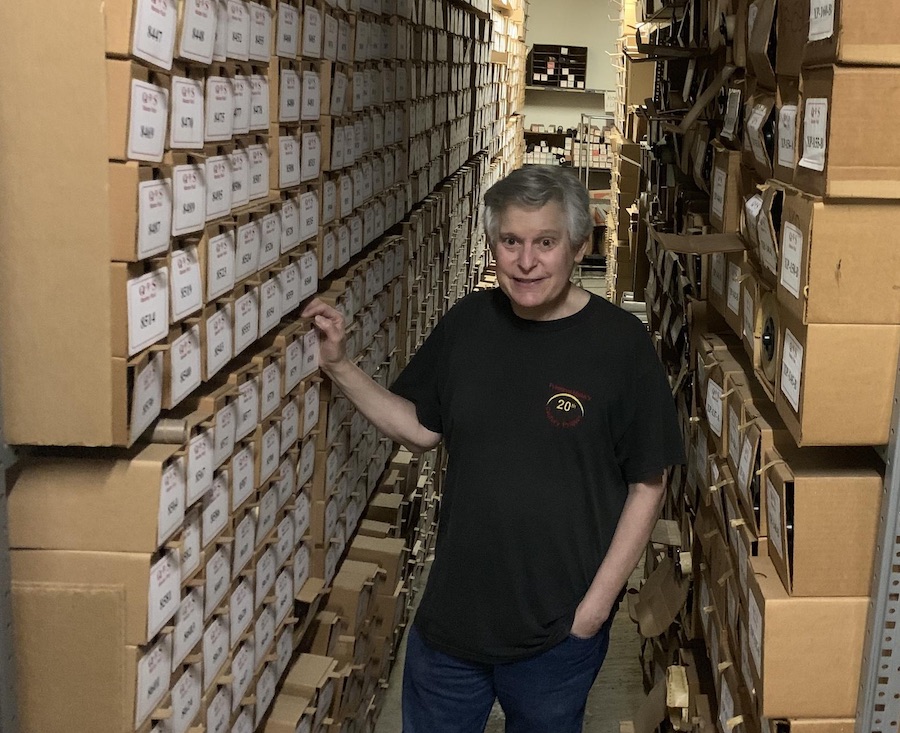
Following the death of Max Kortlander in 1961, his widow Gertrude sold the business to entrepreneur Ramsi P. Tick, who moved the operation to Buffalo, New York, in 1966. While the visitor never got close to regaining its quondam continuing, it did succeed for decades in keeping the legacy of player pianos and music rolls live.
For most of the past 50 years, QRS was the only major scroll manufacturer still actively creating new production—both in the class of re-released classic rolls and new digitized actor piano tech—and the Buffalo era wound up exceeding the lifespan of both the Chicago and Bronx chapters of the visitor history.
Unfortunately, subsequently various stops and starts, the Buffalo establish finally produced its last roll in 2019. QRS Music Technologies, Inc., lives on, however, and every bit of 2021, notwithstanding produces piano rolls on a small calibration at a plant in Seneca, Pennsylvania.
[A tour of the QRS curl factory in Buffalo, NY, from late 1980s Canadian Idiot box plan "The Acme Schoolhouse of Stuff"]
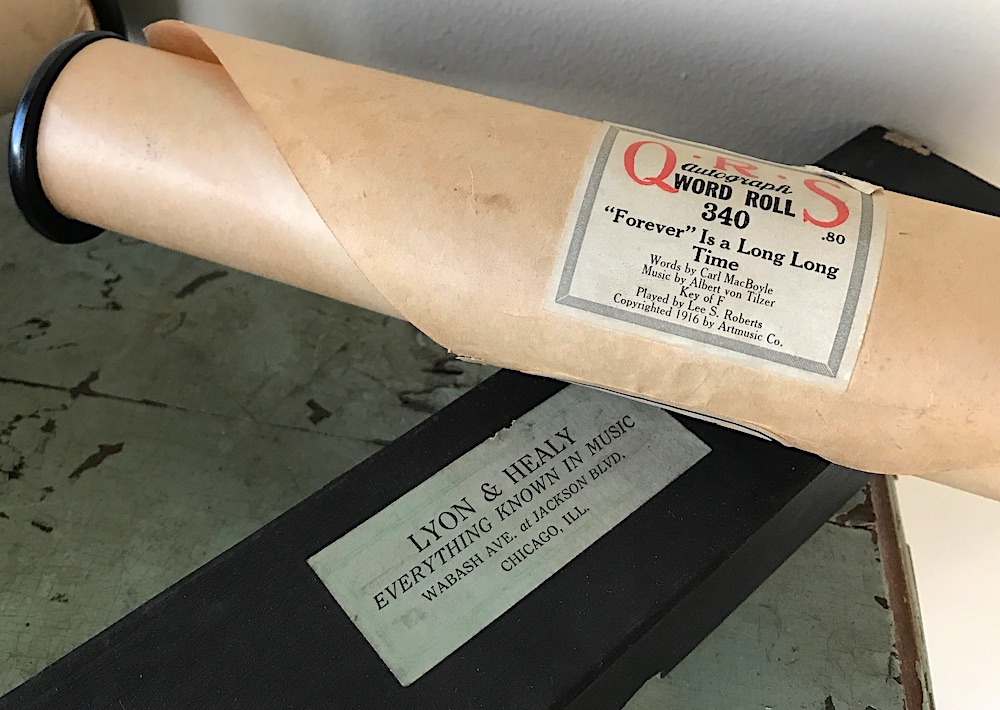
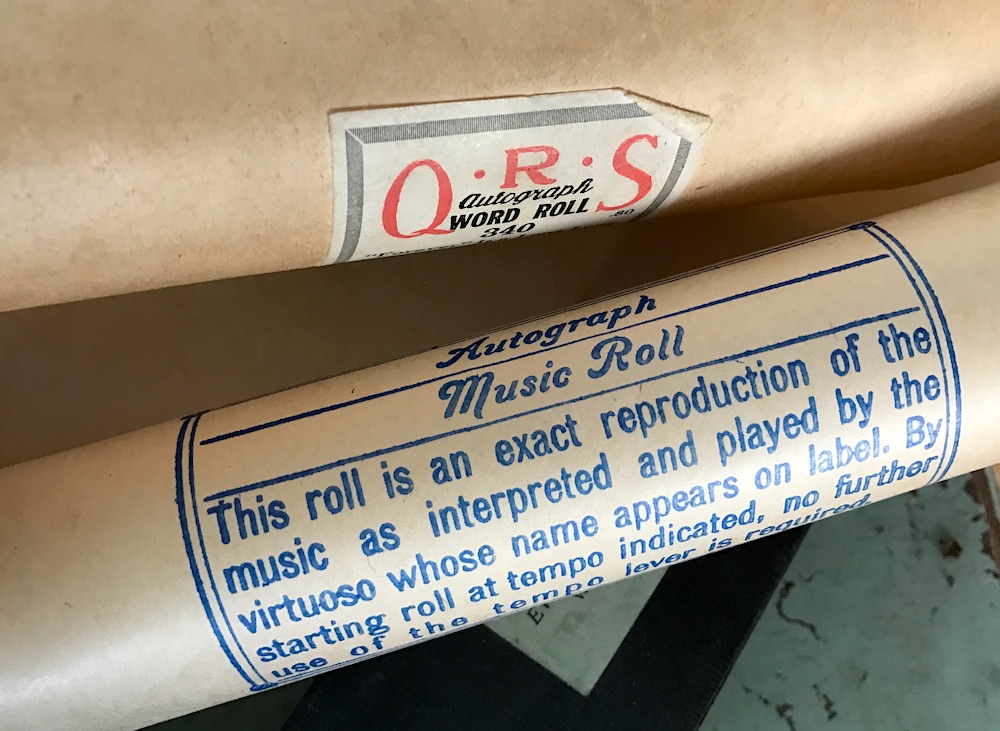

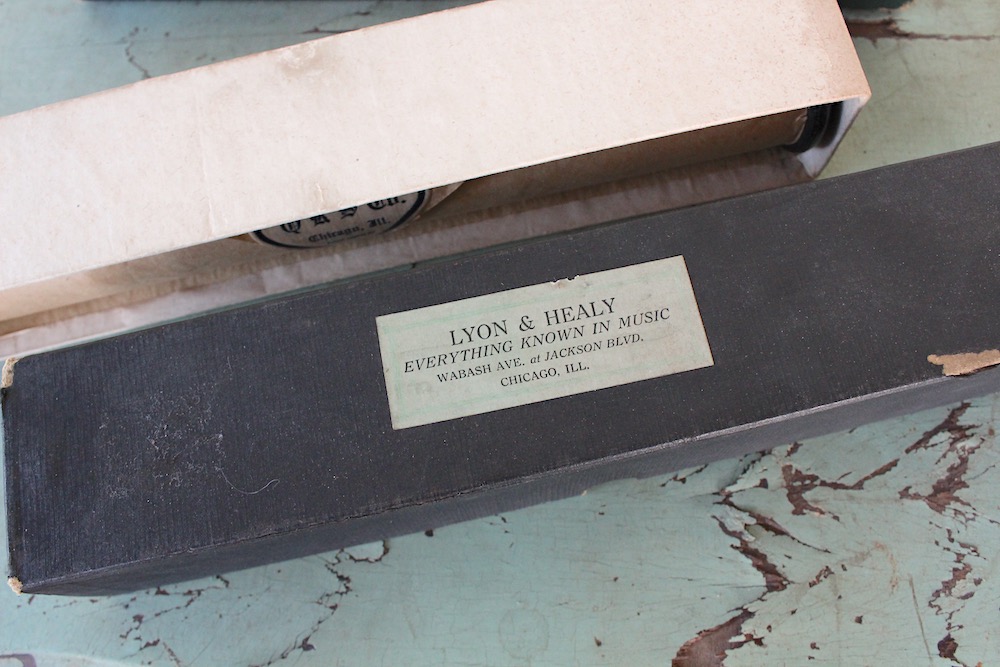
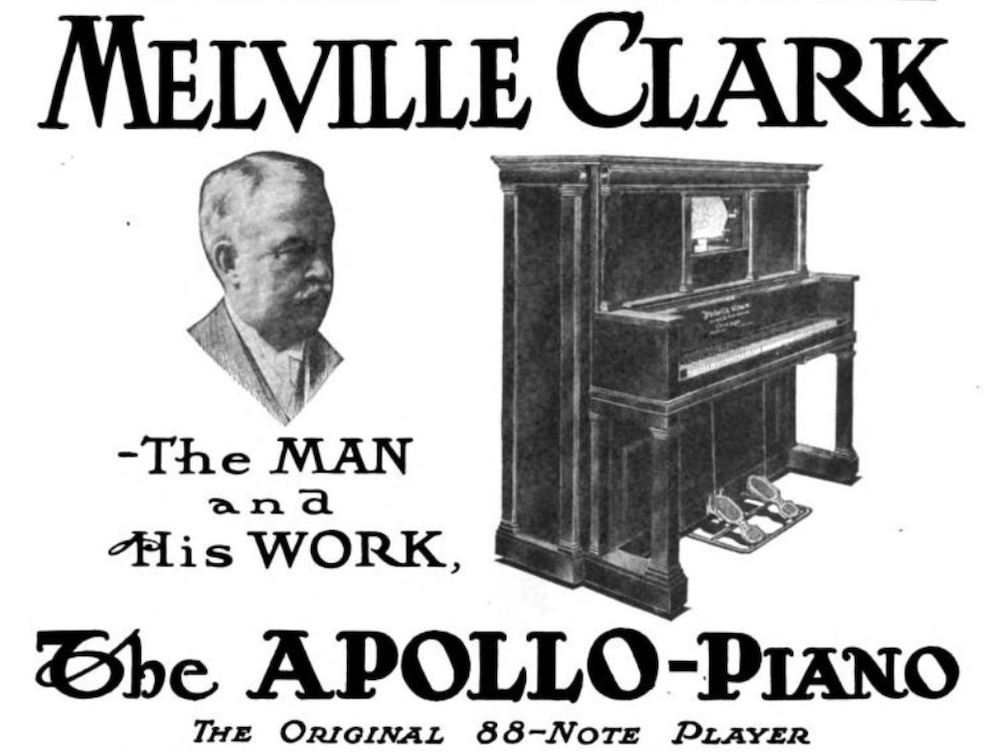
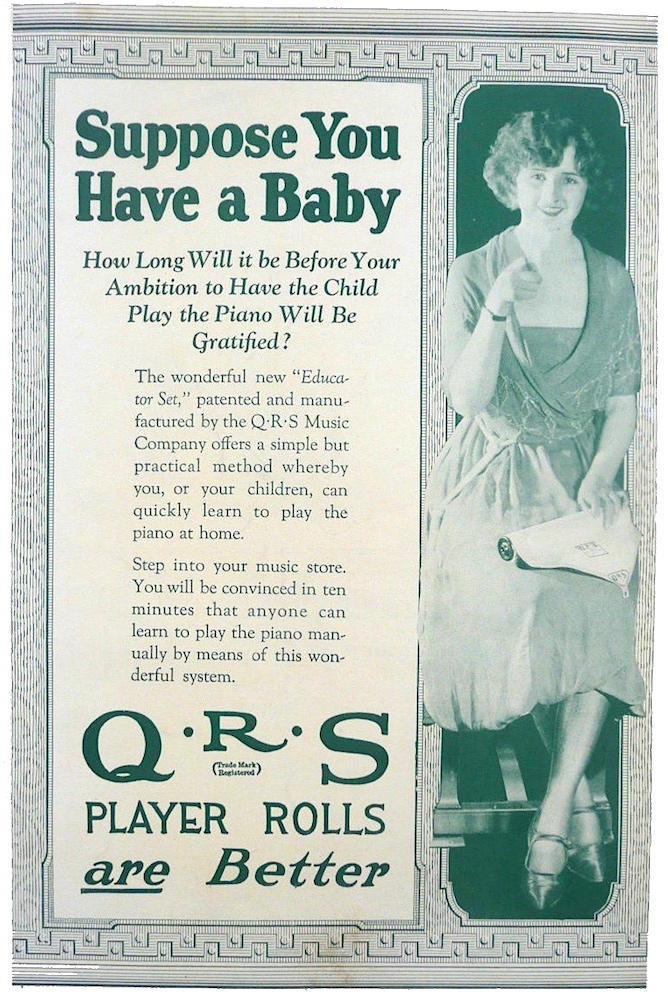
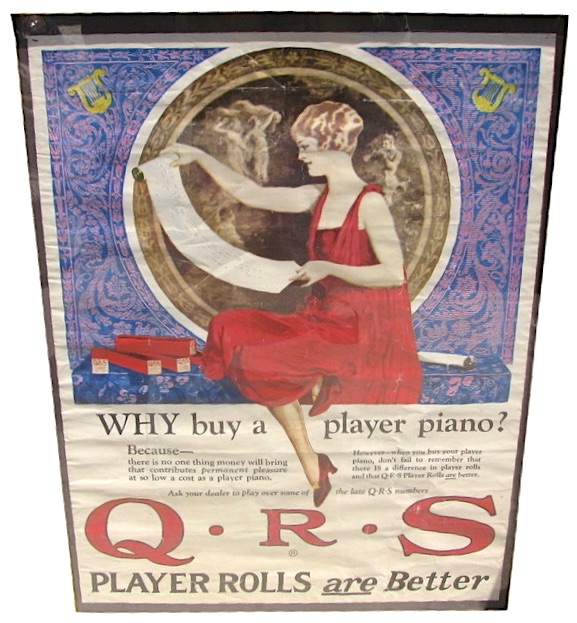
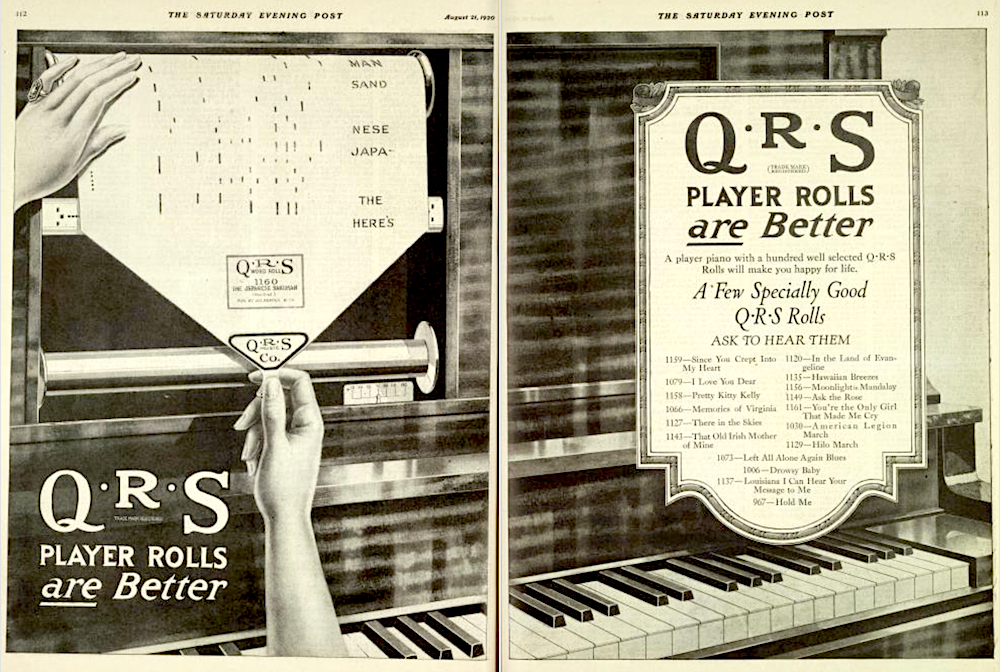
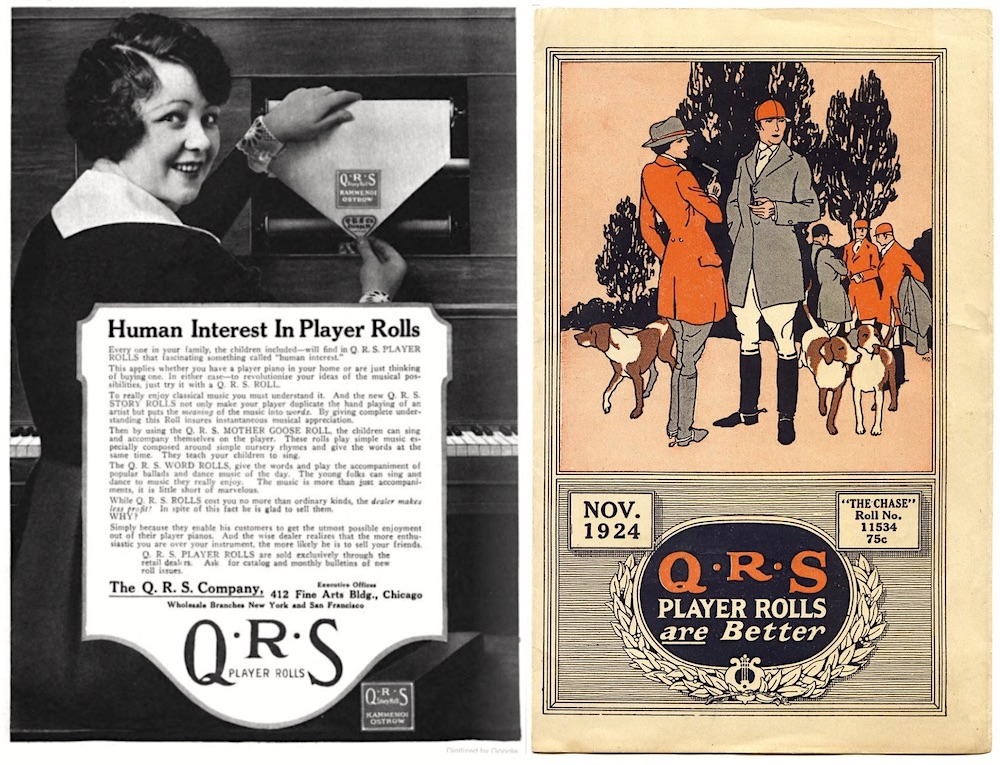
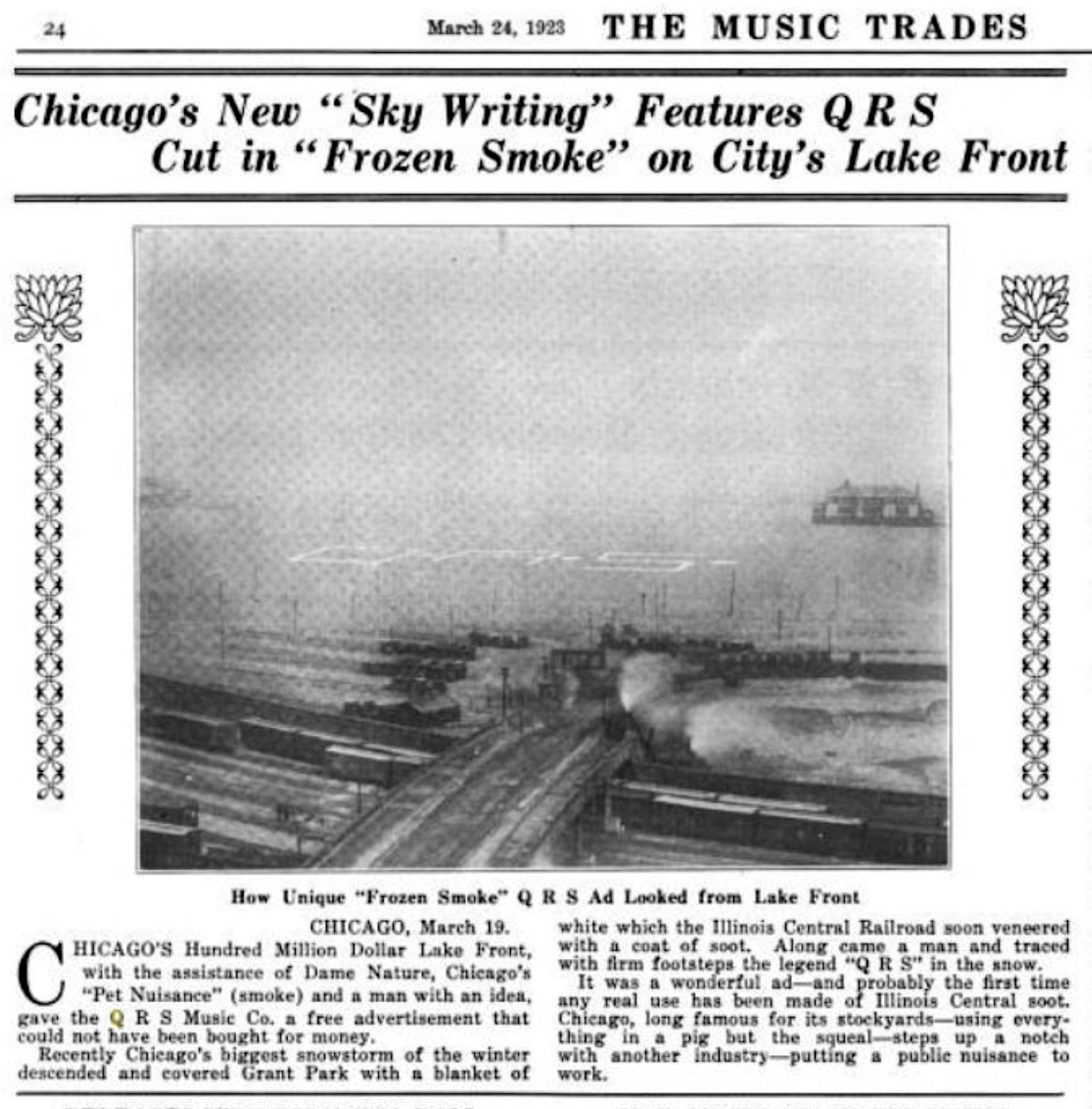
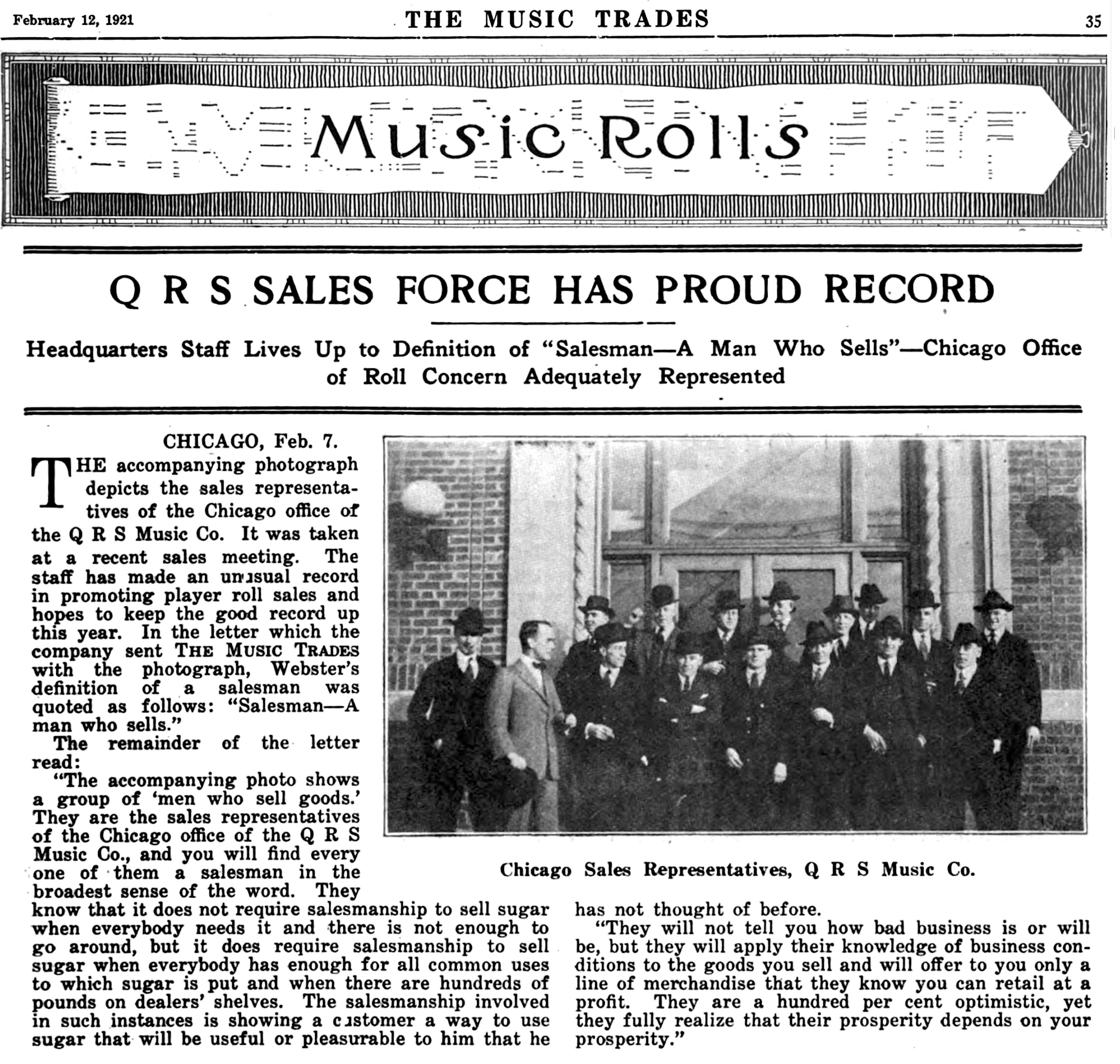
Sources:
Inventing Entertainment: The Actor Piano and the Origins an American Musical Industry, by Brian Dolan, 2009
"The QRS Marking Piano: A National Historic Mechanical Engineering Landmark" – The American Society of Mechanical Engineers, 1992
"Q R S Actor Rolls" – The Purchaser's Guide to the Music Industries, 1922
"The QRS Story" – The Phonographic Record, Vol. 18, Issues three/4, 1983
"Q R Southward Music Co. Enters Roll Chiffonier Field" – The Music Trades, March 31, 1923
"White-Smith Music Publishing Co. vs Apollo Co." – U.S. Supreme Court, 1908
"Federal Trade Committee vs. The Q.R.S. Music Company," 1924
Face Time with Jere DeBacker – DeKalb Daily Chronicle, April 14, 2014
"A Buffalo Love Story: Bob Berkman, the Role player Piano and QRS Music Rolls" – WBFO NPR
"J. Lawrence Melt" – doctorjazz.co.britain
"Max Kortlander: Rex of the Player Piano" – doctorjazz.co.britain
"Maximilian J. Kortlander" – ragpiano.com
"Melville Clark Pianoforte Company" – Mechanical Music Registry Projection
"Q.R.South. Company Have Plans Underway for New Chicago Building" – DeKalb Daily Chronicle, June fourteen, 1919
"New Business organization Will Mean Much to Us" (Wurlitzer buys out Melville Clark Co.), DeKalb Daily Chronicle, Aug xx, 1919
"QRS Autograph Curl Master List" – AMICA News Message, Vol 25, No. 3, May/June 1988
Source: https://www.madeinchicagomuseum.com/single-post/qrs-music/
0 Response to "Family Music Centers Inc, Burgett Inc Vs Qrs Music Inc, Qrs Musis Technologies Inc, Et Al"
Post a Comment